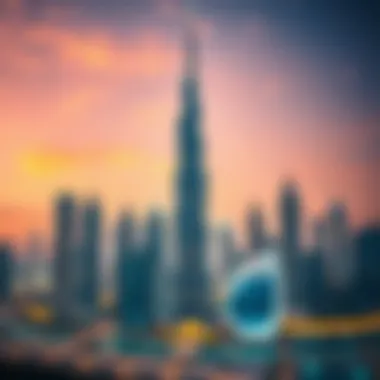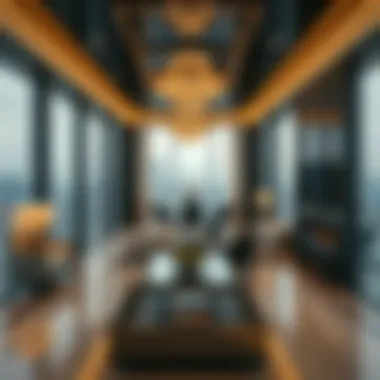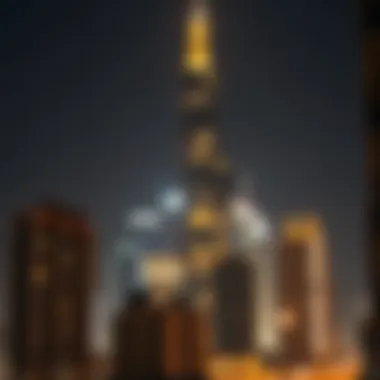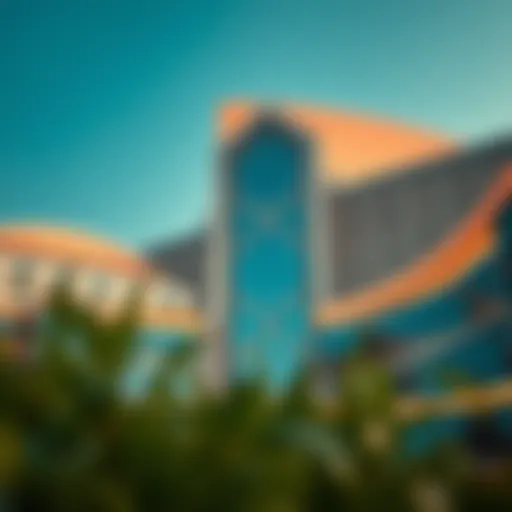Sky Towers: Shaping Dubai's Urban Landscape and Market


Intro
Dubai’s skyline is an ever-evolving canvas, painted with the strokes of architectural ingenuity. Among the most striking features of this landscape are the Sky Towers, monumental structures that not only defy gravity but also redefine urban living. The phenomenon of Sky Towers encompasses more than just their towering heights; they represent a blend of aesthetic beauty, technological advancement, and economic potential. As investors, buyers, and real estate analysts seek to capitalize on the opportunities these architectural wonders present, understanding the intricate dynamics at play within the Dubai property market becomes paramount.
In exploring the essence of Sky Towers, the focus shifts to their architectural significance. These structures are not simply buildings; they're statements, landmarks that embody the ambitions of a city. The investment opportunities they offer are equally compelling, with a myriad of factors influencing the decision-making process for stakeholders. Moreover, the socio-economic implications of these towers extend beyond their immediate surroundings, impacting urban identity, and community dynamics.
This article will dive deep into the architectural marvel of Sky Towers, presenting an extensive analysis that spans from current market conditions and future projections to strategic investment insights. Each section will unfold a new layer of understanding, aimed squarely at discerning readers ready to navigate the complexities of Dubai’s luxury real estate market.
Intro to Sky Towers
In the fast-paced world of urban development, Sky Towers are not just architectural statements; they are beacons of innovation, ambition, and the changing landscapes of cities. As cities around the globe continue to swell, the necessity for space-efficient structures has led to the rise of Sky Towers—these iconic edifices defy traditional architectural norms. In this section, we will delve into why Sky Towers are essential, examining their definitions, frameworks, and historical evolution.
Definition and Conceptual Framework
Sky Towers can be defined as high-rise buildings that exceed a certain height, often characterized by their distinct architectural styles, advanced engineering techniques, and multifaceted uses ranging from residential to commercial. But it's not just about height; it's about how these structures influence urban experiences and contribute to community vibrancy.
They are typically designed to maximize vertical space while integrating seamlessly within their urban context. Such designs may incorporate sustainable materials, energy-efficient systems, and innovative technology, ultimately aiming to improve both the utility and aesthetic of the city’s skyline.
Key Elements of Definition:
- Height Criteria: Varies by region; often refers to structures over 150 meters.
- Mixed-Use Functionality: Includes residential, commercial, and recreational spaces all in one.
- Sustainability: Emphasis on green building practices and smart technology.
Understanding this conceptual framework helps grasp the intricacies involved in developing and investing in Sky Towers. Their significance stretches beyond mere aesthetics; they symbolize progress, economic opportunity, and even cultural identity.
Historical Evolution of Tall Structures
The journey of tall structures dates back to ancient civilizations. Initially, buildings were primarily a reflection of existing technologies and materials. The Great Pyramid of Giza, one of the earliest skyscrapers in its own right, showcased the ingenuity of ancient Egyptians.
Fast forward to the 19th century, and the Home Insurance Building in Chicago marks a pivotal turn in architectural history, being generally credited as the first modern skyscraper due to its steel frame construction. It represented not just height, but also an evolution in engineering possibilities, paving the way for future endeavors.
Many architects in the 20th century took these principles further, focusing on designs that would make a statement. Structures such as the Empire State Building and Chrysler Building emerged as symbols of economic prowess during the Great Depression.
Today, Sky Towers like the Burj Khalifa demonstrate how advances in technology enable even greater heights. As we examine these developments, it becomes evident that every pinnacle reached is built on the foundations laid by previous generations.
"The evolution of Sky Towers represents not just an architectural accomplishment, but also a continuous dialogue between culture, engineering, and urban environment."
Architectural Significance of Sky Towers
Sky Towers stand tall as symbols of human ingenuity and architectural brilliance. They represent progress and ambition, pushing the limits of what can be achieved in urban environments. In the context of this article, understanding the architectural significance of these structures is crucial. They are not merely buildings; they embody a multitude of benefits that impact both the physical landscape and the societal framework.
The importance of Sky Towers can be distilled into several key elements. First, they catalyze urban renewal, breathing new life into areas that might have once been deemed obsolete. By attracting businesses and residents, these towering structures stimulate economic development. Moreover, their design often emphasizes sustainability, setting a precedent for future constructions. In a world grappling with environmental concerns, integrating green principles into tall buildings demonstrates a commitment to balancing growth with ecological responsibility.
Innovative Design Principles
Sustainable Architecture
Sustainable architecture, a fundamental aspect of modern Sky Tower design, focuses on creating structures that harmonize with their environment. This architectural approach seeks to minimize energy consumption and reduce environmental impact through thoughtful design and material selection. The key characteristic of sustainable architecture is its emphasis on efficiency and renewable resources.
One notable feature of sustainable architecture in Sky Towers is the incorporation of energy-efficient systems such as solar panels and rainwater harvesting. This not only benefits the environment but also offers long-term cost savings for building owners. As a beneficial choice in urban development, these principles are becoming increasingly popular among investors looking to differentiate their properties while appealing to eco-conscious clients.
However, one must also consider the challenges. Implementing sustainable practices can initially drive up construction costs. Yet, many within the industry argue that the long-term benefits outweigh these upfront investments.
Smart Building Technologies
The advent of smart building technologies marks another significant trend in Sky Tower design. These technologies facilitate automated control systems that regulate heating, lighting, and security, creating a more user-friendly and efficient environment. A major characteristic of smart buildings is their ability to integrate Internet of Things (IoT) devices, which can optimize energy use and enhance the comfort of residents and workers.
The unique aspect of smart building technologies in Sky Towers is their capability for real-time data collection and analysis. This helps in streamlining operational efficiency and in reducing costs over time. Investors and developers see this as an increasingly favorable choice, as it aligns with the demands of modern occupants who prioritize technology in their living and working spaces.
However, with the rise of smart technologies, there are credible concerns regarding cybersecurity. The increasing connectivity can make these buildings vulnerable to hacking and data breaches, necessitating robust security measures to protect residents and assets.
Sky Towers in Dubai: Landmark Examples
Sky Towers in Dubai exemplify the architectural excellence and innovative design principles discussed above. Two particular structures highlight the significance of these tall edifices.
Burj Khalifa
The Burj Khalifa stands as a crown jewel in the Dubai skyline, renowned for its unparalleled height and striking design. It reaches 828 meters tall, making it the tallest building in the world since its completion in 2010. A unique characteristic of the Burj Khalifa is its triple-lobed footprint, designed to maximize views and natural light while reducing wind force on the structure.
Additionally, the Burj Khalifa incorporates sustainable features, including a condensate recovery system that collects water from the air conditioning system for irrigation. This structure serves as a beneficial focal point for tourists and locals alike, boosting the economy and positioning Dubai as a global city.
Nevertheless, the cost of maintaining such an iconic edifice raises questions about future sustainability, as ongoing expenses might deter potential investors.
Cayan Tower


Cayan Tower, also known as the Infinity Tower, is an architectural marvel recognized for its stunning 90-degree twist from base to top. This design not only distinguishes it from other structures but also aids in managing wind forces more effectively. The key characteristic of Cayan Tower is its innovative twisting form that enhances both aesthetic appeal and structural integrity.
A noteworthy feature of the Cayan Tower is its incorporation of energy-efficient lighting and climate control systems, a significant aspect that attracts environmentally aware tenants. It serves as a popular choice among both luxury residents and corporate tenants looking for modern, stylish spaces.
It's important to acknowledge the challenges faced by Cayan Tower, particularly regarding its unique design. The complex structure increases construction costs and requires specialized labor, which can be a drawback for future projects.
By studying these examples, it becomes evident how Sky Towers can influence urban development, combining extraordinary design with practical considerations to forge an impactful urban identity.
Investment Opportunities in Sky Towers
Investment in Sky Towers represents a pivotal facet of domain of urban development in cities like Dubai. These towering structures not only redefine skylines but also attract substantial financial interest from various players in the real estate market. Such investments promise not just aesthetic appeal but also numerous economic benefits, making this topic crucial for understanding contemporary urban growth and development. Furthermore, the unique characteristics of Sky Towers, including their luxury offerings and strategic locations, contribute significantly to their value as investment opportunities.
Market Trends and Analysis
The landscape of the Sky Tower investments is not static; it evolves with shifting market trends. As cities grow denser, there’s a substantial push toward vertical living. Investors often observe that as urban populations surge, the demand for dwelling spaces in high-rises amplifies as well. Consequently, market analysis indicates a growing preference for mixed-use towers that combine residential, commercial, and recreational spaces. This diversification attracts a broader array of tenants, enabling a steady cash flow for investors.
Moreover, the integration of smart technologies and eco-friendly designs plays a vital role in attracting modern investors. The eco-conscious consumer has become more prevalent, encouraging developers to consider sustainability while reaping financial rewards. The trend is leaning towards buildings that not only provide luxury but also exhibit a commitment to environmental stewardship.
Land Value Increment and ROI
Investment in Sky Towers often translates to significant land value increments, primarily due to their urban location and increasing demand for premium real estate. The trajectory of ROI, or Return on Investment, in these cases can be enthralling for potential investors.
Comparative Investment Approaches
The essence of comparative investment approaches lies in assessing various strategies postulated by real estate investors. Sky Towers, with their lofty ambitions, allow for an analysis of these approaches in the ever-competitive market.
One notable characteristic of this strategy is its focus on evaluating potential projects based on several criteria, such as location, occupancy rates, and construction costs. That makes it inherently beneficial, as it offers insight into what might yield the highest returns.
An example is when investors compare a luxury condominium in the Burj Khalifa to a more modest flat in a nearby area. The former may offer significantly higher margins due to its prestigious brand alone, even as operational costs are higher. However, investors need to be cautious of their unique features, including market volatility and regulatory changes in urban planning, which can affect both short-term gains and long-term stability.
Long-term Value Propositions
Exploring the long-term value propositions of Sky Towers brings to light their enduring worth in urban landscapes. As cities expand and mature, the real estate within them does not merely stand still.
The fundamental characteristic of this proposition is the potential for appreciation over time. Unlike traditional properties, the unique positioning of Sky Towers often leads to increased desirability as urban areas develop. Such stability fosters a reliable investment climate.
A prime example would be when comparing two residential high-rises—one located in Dubai's flourishing Downtown area and another on the city's outskirts. The former generally holds its value over time due to a continuous demand from both locals and expatriates, while the latter might experience stagnation or even depreciation. Weighing these unique traits reveals that while immediate returns might be less pronounced, the potential for enduring value becomes a compelling reason for investors to consider Sky Towers as worthwhile propositions in their portfolios.
"The sky’s not the limit; it's only the beginning" – this resonates perfectly with the opportunities presented by such architectural feats.
Overall, the investment landscape in Sky Towers is complex yet rewarding. By understanding market trends and analyzing long-term potential, investors can navigate this lucrative space with confidence, paving the way toward fruitful investments.
For further reading, you can check resources like Wikipedia or Britannica for comprehensive insights into the history and implications of sky towers.
Any serious investor in the Dubai market should also consider platforms like RED Realtors and Farnek for insights and trends in luxury real estate.
Socio-Economic Impact of Sky Towers
The rise of Sky Towers in urban areas has a profound socio-economic impact that stretches beyond simple architectural beauty and luxury living. These towering structures play a significant role in reshaping urban landscapes and redefining living standards, which carries weight for investors, city planners, and residents alike. The focus on socio-economic factors is crucial to understanding how Sky Towers can contribute to healthier, sustainable, and more connected urban environments.
Urban Density and Living Space
As metropolitan areas continue to burgeon, the demand for housing space draws a growing spotlight on urban density. Sky Towers, often reaching impressive heights, provide a solution to the space crunch faced by cities like Dubai. By building vertically, cities can accommodate more residents without swamping the landscape with sprawling suburbs.
Sky Towers not only enhance urban density but also introduce innovative living solutions. Residents often find that these high-rise apartments come with stunning views and modern amenities. However, it’s important to consider that higher density doesn’t always equate to a better living experience.
Higher density can lead to congested living conditions if urban planners don’t balance development with infrastructural needs. After all, successful urban environments are not merely about tall buildings; they must also attend to essential services such as parks, schools, and transportation. Therefore, urban density through Sky Towers must be approached thoughtfully to avoid potential pitfalls while maximizing urban living space.
Effect on Local Communities
The tall silhouette of Sky Towers doesn’t just occupy space; it can reshape the very fabric of local communities. It can tug at the strings of local culture and traditions, leading to both positive and negative outcomes.
Gentrification
Gentrification is a specific aspect of urban development that's often tied to the rise of Sky Towers. As new high-rises signal economic vitality, neighborhoods may face the influx of wealthier residents and businesses seeking to capitalize on the new developments. This change can lead to the displacement of long-time residents, sparking a mixed bag of reactions.
The key characteristic of gentrification is the transformation of neighborhood demographics. On one hand, it can breathe life into declining areas, introducing new retail options, and improving property values, making it a popular choice among real estate investors. On the other hand, it can erase cultural landmarks and disrupt community cohesion, raising concerns about the social costs of such changes.
In this context, gentrification can be seen as a double-edged sword. While it can lead to economic growth, it may also alienate existing residents if their needs aren’t met. Striking a balance between development and preservation of community identity is, thus, a vital consideration for stakeholders in the urban landscape.
Cultural Implications
Cultural implications are another facet to consider when discussing the impact of Sky Towers on local communities. Unique features of these towering structures can serve as identity markers for cities, symbolizing progress and modernity. They can draw tourists and business, thus injecting cash flow into local economies.
However, as Sky Towers emerge, they often bring about a cultural homogenization that may compromise local uniqueness. The struggle between maintaining authentic local cultures and embracing modern, international architecture can create tensions among residents, investors, and city planners.


Ultimately, addressing the cultural implications of Sky Towers is essential. Developers and city planners should consider how new high-rise developments can resonate with the community's existing historical and cultural narratives, rather than overshadowing them completely.
Understanding the socio-economic impacts of Sky Towers is not just about their size or appearance; it's about the tangible effects they have on community identity, economic prosperity, and the delicate balance of growth and tradition.
Sky Towers and Real Estate Dynamics in Dubai
The discussion surrounding Sky Towers is crucial to understanding the complex fabric of urban development in Dubai. These striking edifices do more than scrape the skyline; they serve as pivotal players in the real estate market, altering its course in significant ways. When one considers the rapid growth of Dubai's urban landscape, one cannot overlook how Sky Towers have transformed both the perceptions and realities of luxury living. The rise of these structures is tied directly to the evolving needs of a modern, cosmopolitan society that craves both aesthetics and functionality.
Luxury Marketing Strategies
Luxury marketing for Sky Towers has evolved into a sophisticated practice that goes beyond mere transactions. It's about crafting an image, a lifestyle that appeals to the affluent. Real estate firms in Dubai employ several strategies to market these towers, including:
- Exclusive Launch Events: Often, a building's grand opening is not just an event—it's a social spectacle. Inviting VIPs, influencers, and potential clients elevates the tower’s status, creating an allure that resonates with wealthy buyers.
- High-End Collaborations: Partnering with luxury brands and designers can accentuate the building’s exclusivity. For instance, incorporating furniture from a prestigious designer can heighten perceived value and desirability.
- Virtual Reality Tours: Utilizing cutting-edge technology allows prospective buyers to experience the high-rise living before it’s even completed, making it an attractive option for investors looking to reserve a unit.
The goal of these strategies is to build an emotional connection with potential buyers, making them feel a part of an elite community. This is a crucial element in a market driven by prestige as much as practicality.
Client Segmentation and Target Groups
Understanding the clientele interested in investing in Sky Towers is vital for effective marketing strategies. Not all buyers are created equal, and their motivations tend to differ significantly. Key client segments include:
- High-Net-Worth Individuals (HNWIs): These are the primary buyers, often seeking investment opportunities while also desiring luxury living conditions.
- Expatriates: Many foreigners are drawn to Dubai for its booming economy and favorable tax landscape. They typically seek residences that not only serve as homes but also reflect their lifestyle aspirations.
- Tourists and Short-Term Renters: Dubai's vibrant tourism industry means that some investors purchase units specifically for short-term rentals, capitalizing on the influx of visitors wanting to experience the city's luxurious lifestyle.
- Corporate Buyers: Companies might purchase multiple units for executive staff or to serve as luxury accommodations for clients and guests, necessitating a different marketing approach focused on amenities and proximity to business hubs.
Understanding these segments allows marketers to tailor their messaging, drawing on the unique desires and needs of each group.
"In the realm of Dubai's real estate, Sky Towers represent both an architectural statement and a sound financial investment, encapsulating the aspirations of a global economy."
Navigating the intricacies of competition, consumer behavior, and market trends in such a dynamic landscape can pose challenges, but with an informed approach, the potential rewards are significant.
Future Prospects of Sky Towers in Urban Planning
The evolving landscape of urban development suggests a pivotal role for sky towers in future city planning. As cities grapple with increasing population density and the demand for sustainable living solutions, sky towers emerge as a viable alternative. Their verticality allows for increased living and commercial spaces without expanding urban footprints, which is essential in metropolitan areas like Dubai.
Sky towers also embody the spirit of modernity and ambition. Investors and developers are drawn to their potential, as they not only symbolize innovation but also represent lucrative opportunities in property markets. Besides aesthetic appeal, they can enhance urban infrastructure and stimulate local economies, thereby harnessing benefits that extend beyond their immediate surroundings.
Sustainability Challenges
While sky towers offer numerous advantages, they also present unique sustainability challenges. One pressing issue is the substantial energy consumption required for heating, cooling, and maintaining internal environments. Energy-efficient designs must be prioritized, with emphasis on integrating renewable energy systems, such as solar panels or wind turbines. Moreover, water usage in high-rise buildings raises eyebrows; innovative water recycling systems and rainwater harvesting methods could mitigate this problem effectively.
The construction process itself poses another challenge. The materials used in erecting these towering structures often carry a hefty carbon footprint. Utilizing greener materials more often, such as recycled steel or timber, may be necessary. Builders must weigh the ecological impact against the need for durability and safety, making it essential to chart a balanced path forward in sustainable development.
"Ultimately, the future of sky towers hinges on how well we can navigate the sustainability maze while maximizing their urban contributions."
Technological Advancements in Construction
Technological progress stands as a crucial transition driver for constructing sky towers. Innovations like Building Information Modeling (BIM) enable architects and engineers to visualize building designs in a 3D environment, improving collaboration among project stakeholders. They can identify potential issues early, which reduces the risk of costly design changes during construction.
Additionally, prefabrication techniques are gaining traction. Components can be built in a controlled environment, enhancing quality and reducing waste. This approach not only saves time on-site but also brings together the best engineering practices with modern architectural designs.
Smart technologies, such as IoT (Internet of Things) sensors, are finding their way into these buildings, creating automated systems that monitor energy usage and optimize comfort levels for residents. This interconnectedness can lead to more adaptive and responsive environments that enhance the quality of life.
As we look ahead, it’s evident that the amalgamation of sustainability efforts and adopting cutting-edge technology can redefine the way we perceive sky towers in urban landscapes. These colossal structures may not just reshape skylines; they may redefine how cities function and prosper.
Challenges Faced by Sky Towers
Sky Towers represent one of the pinnacles of modern architectural design and urban development. However, these structures are not without their challenges. It’s essential to understand the myriad obstacles that developers, investors, and city planners face when erecting such towering edifices. These challenges are not merely bureaucratic hurdles or financial issues; they encompass a broad spectrum of regulatory complexities and economic realities that can shape the fate of a Sky Tower.
Regulatory Hurdles and Compliance
Navigating the maze of regulations is a crucial part of the process when planning a Sky Tower project. Local, national, and sometimes even international laws can govern various aspects of construction, impacting timelines and budgets significantly.
Building codes, for one, can vary widely between jurisdictions. In Dubai, authorities have stringent requirements regarding safety, environmental standards, and even design aesthetics. Failure to comply with these regulations can stall projects or lead to costly fines. For instance, the Dubai Municipality's guidelines dictate specific requirements concerning building materials, height restrictions based on the surrounding landscape, and architectural design standards that honor the cultural heritage of the region.
Moreover, zoning laws can often complicate matters. In some instances, what once seemed a straightforward project can morph into a long-winded negotiation with local authorities. Developers must engage in public consultations, often spending substantial time addressing community concerns. This aspect of regulatory hurdles not only prolongs project timelines but can also lead to significant alterations in design or project scope.
Economic Fluctuations and Market Risk
Economic dynamics pose another formidable challenge for Sky Towers. The market for long-term investments can be particularly volatile, and factors such as geopolitical tensions, shifts in global economic policies, and local market conditions can greatly influence an investor's outlook.
In times of economic downturn, for example, demand for luxury apartments in Sky Towers can plummet. Investors may find themselves facing reduced rental income or empty units, leading to lower overall returns on investment. The Dubai real estate market, known for its boom-and-bust cycles, often illustrates this point vividly. Developers must not only consider current economic climate but also future fluctuations, and adjusting plans accordingly.
Another critical factor is the cost of construction materials, which can vary dramatically based on global demand and supply chains. In recent years, we’ve seen prices fluctuate due to various external factors, including trade wars and crises. As a result, developers must manage their budgets with great precision, often having to source materials from different suppliers to maintain cost-effectiveness.
Understanding these challenges not only helps in crafting a better strategy for Sky Towers but also fosters resilience within the urban market environment.
In addressing these challenges—regulatory and economic— stakeholders must collaborate closely, ensuring a comprehensive approach that emphasizes compliance, sustainability, and adaptability. As they say, in the game of urban development, an ounce of prevention is worth a pound of cure.


Case Studies: A Comparative Analysis
Understanding case studies of prominent sky towers is crucial for grasping their influence on modern urban landscapes. These case studies shed light on the architectural styles, engineering innovations, and socio-economic repercussions that come when we build upwards. They also provide insights into struggles, triumphs, and unique features that define these monumental structures, emphasizing their role as symbols of progress in urban development.
Notable Global Examples
Shanghai Tower
Shanghai Tower stands tall as a beacon of modern engineering and design. It holds the title of the second tallest building in the world. What makes it significant is its unique twisted shape that reduces wind load, a clever adaptation to its environment, thus increasing safety and stability.
This tower is not just about height; it’s also a sustainable marvel. It boasts sky gardens at various intervals, allowing for fresh air and greenery. Moreover, the building utilizes a double-skin facade, which enhances thermal performance and reduces energy consumption. These features allow Shanghai Tower to serve as both a striking architectural piece and a model of how skyscrapers can be built sustainably. For investors, its design principles not only appeal aesthetically but also align with modern values of sustainability, making it a popular focus in discussions about urban development.
Advantages of Shanghai Tower:
- It showcases achievements in sustainable construction.
- It offers a mixed-use space combining offices, hotels, and retail options.
Disadvantages:
- High construction costs due to advanced design
One World Trade Center
One World Trade Center, also known as the Freedom Tower, holds deep significance. Rising from the ashes of its predecessor, it represents resilience and hope. What stands out is its elevated base, which provides security against potential threats, while maintaining an aesthetic appeal that respects history.
Structurally, it showcases cutting-edge safety features, including reinforced steel and blast-resistant glass. This tower also highlights technological integration, as its energy-efficient systems make it not only a functional space but also a pioneer in applying smart building technologies. As such, One World Trade Center is a centerpiece in discussions about safety in urban planning and rebuilding after disaster.
Advantages of One World Trade Center:
- Balances modern technology with historical significance.
- Serves as a gathering point, enhancing community identity.
Disadvantages:
- The perception of security measures can deter some visitors.
Lessons Learned from International Projects
Analyzing these international projects yields invaluable lessons for future developments. Key takeaways include the need for blending architectural vision with practicality, prioritizing sustainability, and incorporating security measures that suffice modern requirements. Moreover, the collaboration between various stakeholders such as architects, builders, and local governments emerges as vital for the success of any sky tower project.
Additionally, a crucial lesson revolves around the understanding of community dynamics. The influence of sky towers extends beyond mere aesthetics; they can dramatically redirect the flow of urban life, affecting housing markets, local businesses, and social interactions—underscoring the need for a thoughtful approach in their planning and design.
Compelling case studies of these towering structures inspire a reevaluation of urban spaces worldwide as we continue to reach for the skies. For more insights on urban architecture, you can visit Wikipedia or Britannica.
The Role of Sky Towers in Revamping Urban Identity
The emergence of sky towers in urban environments marks a transformative shift in how cities construct their identities. It goes beyond mere height or architectural finesse; it's about how these towering structures redefine the very essence of urban living. Each sky tower becomes a beacon of progress, reflecting the aspirations of a city while contributing significantly to its socio-cultural fabric. Their role is profound in shaping not only the skyline but also the lived experiences of individuals who navigate these urban landscapes.
Symbolism and Cultural Representation
Sky towers serve as powerful symbols that represent much more than just architectural prowess. They encapsulate the ethos of a city and resonate with its inhabitants and visitors alike. For instance, in Dubai, structures like the Burj Khalifa don’t merely spike into the clouds; they are emblematic of the nation's journey towards modernization and global recognition.
- Cultural Significance: Each tower often incorporates elements that draw from local culture and history. For example, the design of the Cayan Tower reflects the Islamic architectural traditions while embracing modern aesthetics. This blend can spark a sense of pride among locals.
- Global Connectivity: A sky tower, by virtue of its stature, can serve as a focal point for international discourse and tourism. Think of how the iconic skyline of Dubai attracts millions; it’s not just real estate—it’s a global stage for culture.
- Identity and Unity: In many cases, these towers function as gathering spots, emphasizing community cohesiveness. As spaces of commerce, dining, and leisure, they reinforce the identity of neighborhoods, each telling its own story through architectural language.
"Sky towers are not just buildings; they are living narratives that embody the aspirations and identities of their cities."
Impact on Tourism and Local Economy
The presence of sky towers does wonders for local economies, intertwining with tourism to create an ecosystem of growth. When tourists flock to see these architectural marvels, they bring with them a potential goldmine for local businesses.
- Tourist Attractions: Iconic values draw in visitors. The view from the top of the Burj Khalifa is not just breathtaking; it’s a magnetic force. Each ticket sold contributes directly to local coffers, boosting sectors ranging from retail to hospitality.
- Job Creation: The construction and upkeep of these enormous structures create jobs. From skilled workers during their build phases to service industry roles, the ripple effect influences a wider economic sphere.
- Spillover Effects: Increased foot traffic around these towers can lead to an uptick in sales for nearby restaurants, cafes, and shops. This dynamic creates a vibrant local atmosphere, often turning once-quiet neighborhoods into bustling hubs of activity.
Finales and Future Directions
The topic of Sky Towers carries considerable weight in the context of urban development, especially in rapidly growing cities like Dubai. These towering structures don't just alter skylines; they reshape perceptions, business dynamics, and community interactions. The importance of concluding this article with reflections on both recap of key insights and encouraging sustainable development practices cannot be understated. These points serve as a guiding light for investors and stakeholders who navigate the intricate maze of the luxury property market.
Sky Towers symbolize the ambition and innovation that define modern architecture, often acting as both cultural icons and real estate powerhouses. They serve multipurpose functions, housing luxury condominiums, corporate offices, and hospitality venues. For investors, understanding the architectural significance and socio-economic impacts of these towers underscores their long-term viability as assets.
As we look forward, the need for sustainability cannot be ignored. The gravity of environmental challenges such as climate change propels us to rethink how these monumental structures can be designed and constructed. The focus on sustainable practices not only preserves the environment but also enhances the marketability of these properties.
"Sky Towers are not just buildings; they're symbols of urban identity and economic potential."
Recap of Key Insights
Reflecting on the insights presented throughout this article, a few key themes emerge:
- Architectural Innovation: Sky Towers in Dubai exemplify cutting-edge design, integrating smart technology and sustainable practices. The likes of Burj Khalifa and Cayan Tower showcase this trend, merging elegance with efficiency.
- Investment Viability: Understanding market trends allows stakeholders to seize lucrative opportunities in real estate. Towers represent significant land value increases.
- Societal Impact: The implications for local communities are profound. While these structures promote tourism and urban identity, they must be approached with sensitivity to cultural contexts.
Encouraging Sustainable Development Practices
A push for sustainable development in the context of Sky Towers is essential for fostering future growth without compromising our planet. Here are a few points to consider:
- Green Building Standards: Incorporating LEED or BREEAM certifications can elevate a project’s value and appeal.
- Energy Efficiency: Utilizing renewable energy sources, such as solar panels, can drastically cut down operational costs while reducing carbon footprints.
- Community Engagement: Engaging local communities in the planning stages ensures that developments meet both their needs and preserve cultural heritages.
- Smart Technologies: Implementing IoT devices for building management can optimize resource use, reducing waste significantly.









